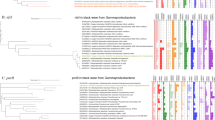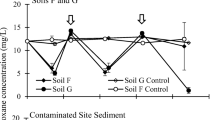Abstract
The explosive hexahydro-1,3,5-trinitro-1,3,5-triazine (RDX) has long been recognized as a problematic environmental pollutant, and efforts to remediate contaminated soils, sediments, and groundwater have been going on for decades. In recent years, much interest has focused on using bioremediation to clean up these sites. The current study investigated the microorganisms (16S rRNA genes, Illumina) and functional genes (xenA, xenB, and xplA) linked to RDX biodegradation in microcosms composed of sediment or groundwater from two Navy sites. For this, experiments included sediment samples from three depths (5 to 30 ft) from two wells located in one Navy site. In addition, the groundwater upstream and downstream of an emulsified oil biobarrier was examined from another Navy site. Further, for the groundwater experiments, the effect of glucose addition was explored. For the sediment experiments, the most enriched phylotypes during RDX degradation varied over time, by depth and well locations. However, several trends were noted, including the enrichment of Pseudomonas, Rhodococcus, Arthrobacter, and Sporolactobacillus in the sediment microcosms. For the groundwater-based experiments, Pseudomonas, unclassified Rhodocyclaceae, Sphingomonas, and Rhodococcus were also highly abundant during RDX degradation. The abundance of both xplA and xenA significantly increased during RDX degradation compared to the control microcosms for many treatments (both groundwater and sediment microcosms). In a limited number of microcosms, the copy number of the xenB gene increased. Phylotype data were correlated with functional gene data to highlight potentially important biomarkers for RDX biodegradation at these two Navy sites.








Similar content being viewed by others
References
Andeer P, Stahl DA, Lillis L, Strand SE (2013) Identification of microbial populations assimilating nitrogen from RDX in munitions contaminated military training range soils by high sensitivity stable isotope probing. Environ Sci Technol 47(18):10356–10363
Andeer PF, Stahl DA, Bruce NC, Strand SE (2009) Lateral transfer of genes for hexahydro-1,3,5-trinitro-1,3,5-triazine (RDX) degradation. Appl Environ Microbiol 75(10):3258–3262
Bernstein A, Adar E, Nejidat A, Ronen Z (2011) Isolation and characterization of RDX-degrading Rhodococcus species from a contaminated aquifer. Biodegradation 22(5):997–1005
Bhushan B, Halasz A, Spain JC, Hawari J (2002) Diaphorase catalyzed biotransformation of RDX via N-denitration mechanism. Biochem Bioph Res Co 296(4):779–784. doi:10.1016/S0006-291x(02)00874-4
Blehert DS, Fox BG, Chambliss GH (1999) Cloning and sequence analysis of two Pseudomonas flavoprotein xenobiotic reductases. J Bacteriol 181(20):6254–6263
Caporaso JG, Lauber CL, Walters WA, Berg-Lyons D, Lozupone CA, Turnbaugh PJ, Fierer N, Knight R (2011) Global patterns of 16S rRNA diversity at a depth of millions of sequences per sample. P Natl Acad Sci USA 108:4516–4522
Chakraborty S, Sakka M, Kimura T, Sakka K (2008) Cloning and expression of a Clostridium kluyveri gene responsible for diaphorase activity. Biosci Biotech Bioch 72(3):735–741. doi:10.1271/bbb.70606
Cho KC, Lee DG, Fuller ME, Hatzinger PB, Condee CW, Chu KH (2015) Application of 13C and 15N stable isotope probing to characterize RDX degrading, microbial communities under different electron-accepting conditions. J Hazard Mater 297:42–51
Cho KC, Lee DG, Roh H, Fuller ME, Hatzinger PB, Chu KH (2013) Application of 13C stable isotope probing to identify RDX-degrading microorganisms in groundwater. Environ Pollut 178:350–360. doi:10.1016/j.envpol.2013.03.033
Chong CS, Sabir DK, Lorenz A, Bontemps C, Andeer P, Stahl DA, Strand SE, Rylott EL, Bruce NC (2014) Analysis of the xplAB containing gene cluster involved in the bacterial degradation of the explosive hexahydro-1,3,5-trinitro-1,3,5-triazine. Appl Environ Microbiol 80(21):6601–6610. doi:10.1128/aem.01818-14
Coleman NV, Nelson DR, Duxbury T (1998) Aerobic biodegradation of hexahydro-1,3,5-trinitro-1,3,5-triazine (RDX) as a nitrogen source by a Rhodococcus sp., strain DN22. Soil Bio Biochem 30(8–9):1159–1167
Cupples AM (2013) RDX degrading microbial communities and the prediction of microorganisms responsible for RDX bioremediation. Int Biodeter Biodegr 85:260–270
Fuller ME, McClay K, Hawari J, Paquet L, Malone TE, Fox BG, Steffan RJ (2009) Transformation of RDX and other energetic compounds by xenobiotic reductases xenA and xenB. Appl Micro Biotech 84(3):535–544
Fuller ME, McClay K, Higham M, Hatzinger PB, Steffan RJ (2010a) Hexahydro-1,3,5-trinitro-1,3,5-triazine (RDX) bioremediation in groundwater: are known RDX-degrading Bacteria the dominant players? Bioremed J 14(3):121–134. doi:10.1080/10889868.2010.495367
Fuller ME, Perreault N, Hawari J (2010b) Microaerophilic degradation of hexahydro-1,3,5-trinitro-1,3,5-triazine (RDX) by three Rhodococcus strains. Lett Appl Micro 51(3):313–318
Halasz A, Manno D, Perreault NN, Sabbadin F, Bruce NC, Hawari J (2012) Biodegradation of RDX nitroso products MNX and TNX by cytochrome P450 XplA. Environ Sci Technol 46(13):7245–7251
Hatt JK, Ritalahti KM, Ogles DM, Lebron CA, Loffler FE (2013) Design and application of an internal amplification control to improve Dehalococcoides mccartyi 16S rRNA gene enumeration by qPCR. Environ Sci Technol 47(19):11131–11138. doi:10.1021/es4019817
Indest KJ, Crocker FH, Athow R (2007) A TaqMan polymerase chain reaction method for monitoring RDX-degrading bacteria based on the xplA functional gene. J Microbiol Meth 68(2):267–274
Jackson RG, Rylott EL, Fournier D, Hawari J, Bruce NC (2007) Exploring the biochemical properties and remediation applications of the unusual explosive-degrading P450 system XplA/B. P Natl Acad Sci USA 104(43):16822–16827
Jayamani I, Cupples AM (2015a) A comparative study of microbial communities in four soil slurries capable of RDX degradation using Illumina sequencing. Biodegradation 26:247–257
Jayamani I, Cupples AM (2015b) Stable isotope probing reveals the importance of Comamonas and Pseudomonadaceae in RDX degradation in samples from a Navy detonation site. Environ Sci Pollut R 22(13):10340–10350. doi:10.1007/s11356-015-4256-6
Jayamani I, Manzella MP, Cupples AM (2013) RDX degradation potential in soils previously unexposed to RDX and the identification of RDX-degrading species in one agricultural soil using stable isotope probing. Water Air Soil Poll 224(10):1745–1760
Kanitkar Y, Stedtfeld RD, Steffan RJ, Hashsham SA, Cupples AM (2016) Development of loop mediated isothermal amplification (LAMP) for rapid detection and quantification of Dehalococcoides spp. biomarker genes in commercial reductive dechlorinating cultures KB-1 and SDC-9. Appl Environ Microbiol 82:1799–1806
Li RW, Giarrizzo JG, Wu ST, Li WZ, Duringer JM, Craig AM (2014) Metagenomic insights into the RDX-degrading potential of the ovine rumen microbiome. PLoS One 9(11). doi:10.1371/journal.pone.0110505
Nejidat A, Kafka L, Tekoah Y, Ronen Z (2008) Effect of organic and inorganic nitrogenous compounds on RDX degradation and cytochrome P-450 expression in Rhodococcus strain YH1. Biodegradation 19(3):313–320
Pruesse E, Quast C, Knittel K, Fuchs BM, Ludwig W, Peplies J, Gloeckner FO (2007) SILVA: a comprehensive online resource for quality checked and aligned ribosomal RNA sequence data compatible with ARB. Nucl Acids Res 35(21):7188–7196
Ritalahti KM, Amos BK, Sung Y, Wu QZ, Koenigsberg SS, Loffler FE (2006) Quantitative PCR targeting 16S rRNA and reductive dehalogenase genes simultaneously monitors multiple Dehalococcoides strains. Appl Environ Microbiol 72:2765–2774
Roh H, Yu CP, Fuller ME, Chu KH (2009) Identification of hexahydro-1,3,5-trinitro-1,3,5-triazine-degrading microorganisms via 15N stable isotope probing. Environ Sci Technol 43(7):2505–2511. doi:10.1021/es802336c
Rylott EL, Jackson RG, Sabbadin F, Seth-Smith HMB, Edwards J, Chong CS, Strand SE, Grogan G, Bruce NC (2011) The explosive-degrading cytochrome P450 XplA: Biochemistry, structural features and prospects for bioremediation. Bba-Proteins Proteom 1814(1):230–236. doi:10.1016/j.bbapap.2010.07.004
Schloss PD (2009) A high-throughput DNA sequence aligner for microbial ecology studies. PLoS 4(12)
Seth-Smith HMB, Edwards J, Rosser SJ, Rathbone DA, Bruce NC (2008) The explosive-degrading cytochrome P450 system is highly conserved among strains of Rhodococcus spp. Appl Environ Microbiol 74(14):4550–4552
Seth-Smith HMB, Rosser SJ, Basran A, Travis ER, Dabbs ER, Nicklin S, Bruce NC (2002) Cloning, sequencing, and characterization of the hexahydro-1,3,5-trinitro-1,3,5-triazine degradation gene cluster from Rhodococcus rhodochrous. Appl Environ Microbiol 68(10):4764–4771
Stedtfeld RD, Stedtfeld TM, Kronlein M, Seyrig G, Steffan RJ, Cupples AM, Hashsham SA (2014) DNA extraction-free quantification of Dehalococcoides spp. in groundwater using a hand-held device. Environ Sci Technol 48(23):13855–13863. doi:10.1021/es503472h
Thompson KT, Crocker FH, Fredrickson HL (2005) Mineralization of the cyclic nitramine explosive hexahydro-1,3,5-trinitro-1,3,5-triazine by Gordonia and Williamsia spp. Appl Environ Microbiol 71(12):8265–8272
Watrous MM, Clark S, Kutty R, Huang S, Rudolph FB, Hughes JB, Bennett GN (2003) 2,4,6-trinitrotoluene reduction by an Fe-only hydrogenase in Clostridium acetobutylicum. Appl Environ Microbiol 69(3):1542–1547
Acknowledgments
This research was supported by a grant to A. M. Cupples from Strategic Environmental Research and Development Program (SERDP Project ER1606).Thanks to Mark E. Fuller and Paul Hatzinger (CB&I Federal Services) for providing groundwater samples. Thanks to David Liu (Naval Facilities Engineering Command Northwest) and Mandy Michalsen (USACE, Seattle District) for providing the sediment samples.
Author information
Authors and Affiliations
Corresponding author
Ethics declarations
Conflict of interest
The authors declare that they have no competing interests.
Ethical approval
This article does not contain any studies with human participants or animals.
Electronic supplementary material
ESM 1
(PDF 191 kb)
Rights and permissions
About this article
Cite this article
Wilson, F.P., Cupples, A.M. Microbial community characterization and functional gene quantification in RDX-degrading microcosms derived from sediment and groundwater at two naval sites. Appl Microbiol Biotechnol 100, 7297–7309 (2016). https://doi.org/10.1007/s00253-016-7559-8
Received:
Revised:
Accepted:
Published:
Issue Date:
DOI: https://doi.org/10.1007/s00253-016-7559-8




